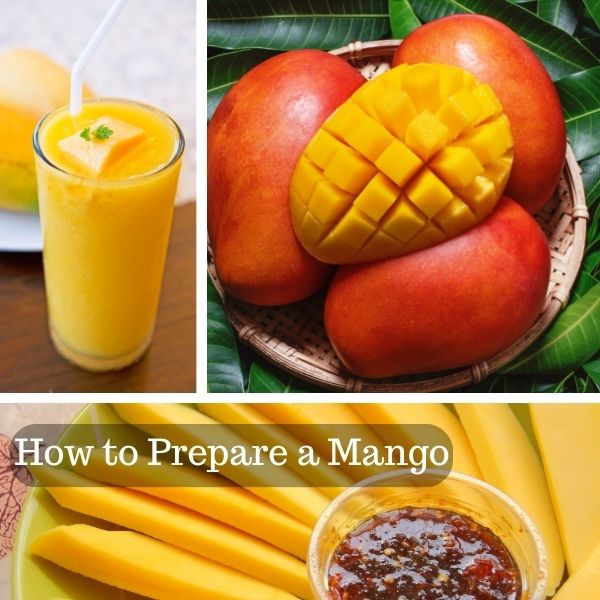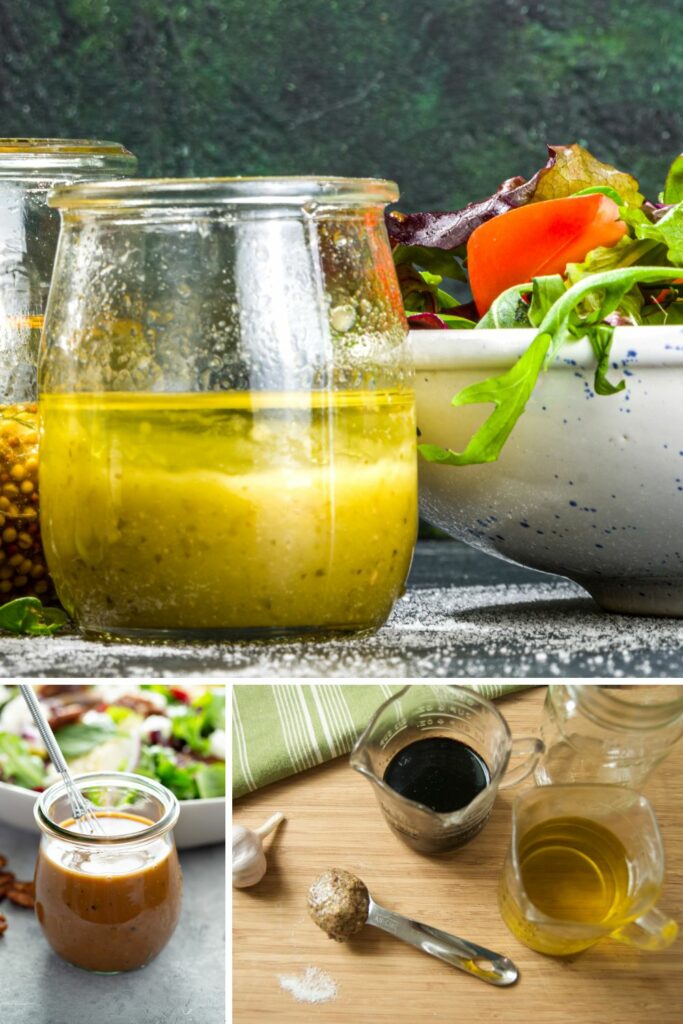Welcome to your ultimate guide on preparing mangoes, the king of fruits! If you’ve ever found yourself puzzled in the kitchen with a ripe mango in hand, unsure of how to tackle its slippery texture and large pit, you’re not alone. Mangoes, with their luscious taste and vibrant color, can elevate any dish, from sweet desserts to tangy salsas. Yet, many home cooks hesitate at the thought of preparing them. Fear not! This guide is here to demystify the process, turning what can be a daunting task into a simple, enjoyable experience.
In this article, we’ll guide you through everything you need to know about mangoes. Have you ever wondered how to pick the perfect mango from a sea of choices at the grocery store? Or pondered over the best technique to extract every bit of its juicy goodness? We have you covered! We’ll begin by exploring the diverse world of mango varieties. Each type has its unique flavor and texture, suited for different culinary uses. Understanding these differences is crucial in selecting the right mango for your dish.
Next, we delve into the art of determining ripeness. A perfectly ripe mango can enhance your dish’s flavor exponentially. We’ll share expert tips to help you identify the peak ripeness of a mango, not just by its color, but through touch and smell. This knowledge is key to ensuring that your mango is at its flavorful best when you slice into it.
But the heart of this guide lies in the cutting techniques. Cutting a mango may seem intimidating due to its slippery nature and the large, flat seed in the middle. However, with our step-by-step instructions, complete with hand-drawn illustrations, you’ll master various methods to cut a mango like a pro. Whether you’re looking to create elegant slices, perfect cubes, or just want to scoop out the flesh to enjoy immediately, we’ve got all the techniques laid out for you.
So, grab your mango, a sharp knife, and let’s embark on this culinary journey together. By the end of this guide, you’ll not only be adept at preparing mangoes but will also discover the joy and satisfaction in doing so. Let’s turn your mango apprehensions into a mango celebration!
Understanding Mango Varieties
Exploring the World of Mangoes:
Did you know that there are over a thousand varieties of mangoes worldwide? Each variety brings its own unique flavor, texture, and color to the table. In this section, we’re going to take a closer look at some of the most popular varieties you might come across in your local market.
The Alphonso Mango: Often hailed as the “King of Mangoes,” Alphonso mangoes are prized for their incredible sweetness and creamy texture. Originating from India, these mangoes have a rich, smooth pulp that makes them ideal for desserts and smoothies. Their vibrant saffron-colored flesh is not just a feast for the taste buds but also for the eyes.
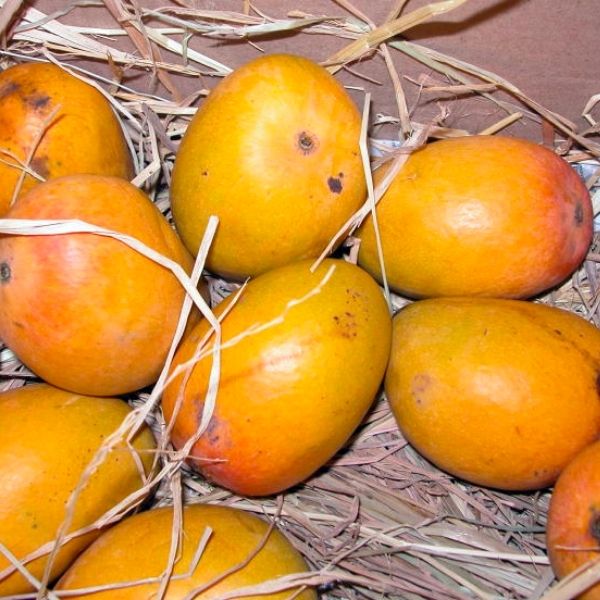
The Tommy Atkins Mango: A stark contrast to the Alphonso, the Tommy Atkins mango is known for its firmer, fibrous flesh. This variety, predominantly found in the U.S., has a mildly sweet and tangy flavor. Its sturdy structure makes it perfect for salads and salsas where you need the mango to hold its shape.
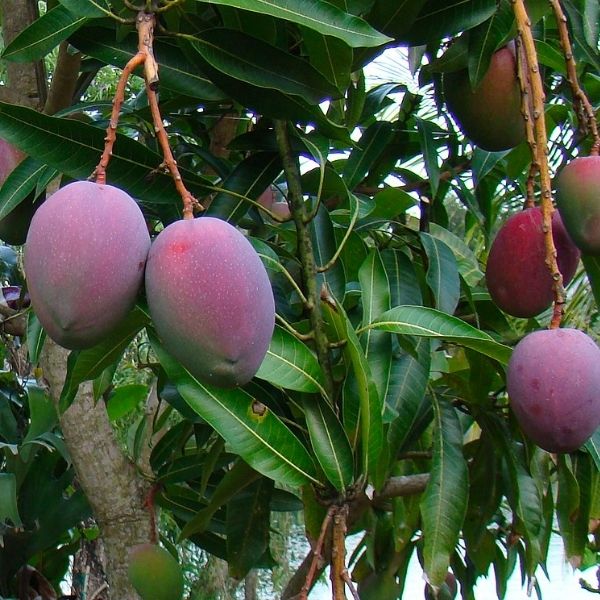
The Ataulfo Mango: Also known as the “Honey” or “Champagne” mango, the Ataulfo mango from Mexico is small, kidney-shaped, and has a buttery, creamy texture with a sweet, honey-like flavor. With less fibrous and a smaller pit, it’s a great choice for slicing and dicing.
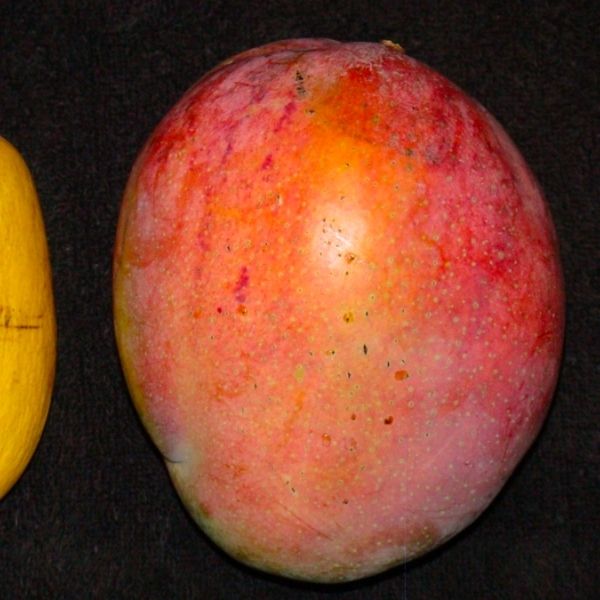
Taste and Texture:
Understanding the taste and texture of different mango varieties is crucial in selecting the right one for your dish. Here are some tips to help you navigate through these choices:
- For Juicing and Smoothies: Choose mangoes with a sweeter profile and creamy texture, like the Alphonso or Ataulfo.
- For Salads and Salsas: Opt for firmer mangoes like the Tommy Atkins or Keitt, which hold their shape and add a tangy flavor.
- For Baking and Desserts: Go for mangoes with a rich, sweet flavor and smooth pulp, like the Haden or Kent.
Now that you’re familiar with the various types of mangoes and their culinary uses, you’ll be able to pick the perfect mango for your next culinary adventure. Up next, we’ll dive into how to select the perfectly ripe mango, ensuring your dish is nothing short of spectacular.
Selecting the Perfect Mango
Ripeness Matters:
Choosing a ripe mango is not just about getting the best flavor—it’s also about ensuring the right texture for your dish. Here’s how you can become a pro at selecting the perfect mango every time.
Color is Not Always Key: While color changes can indicate ripeness, it’s not a foolproof method due to the vast variety of mangoes. For instance, the Alphonso mango turns a deep golden yellow when ripe, while the Tommy Atkins retains much of its green even when it’s ready to eat.
The Feel Test: Gently press the mango with your thumb. A ripe mango will yield slightly, showing a softness without being mushy. Think of it like checking an avocado for ripeness.
Aroma Tells a Tale: Bring the mango close to your nose. A ripe mango will emit a sweet, fruity aroma at the stem end. The stronger the scent, the riper the mango.
Mango Ripeness and Preparation:
The ripeness of your mango affects how you should prepare it. Here’s a quick guide:
- Firm Mangoes: Ideal for dicing or slicing as they hold their shape better. Perfect for salads, salsas, or as toppings.
- Soft, Ripe Mangoes: Best for purees, smoothies, or desserts where the mango’s creamy texture can shine.
- Overripe Mangoes: Don’t throw them away! Overripe mangoes are great for sauces, jams, or in baking, where their heightened sweetness and softer texture can be a boon.
Understanding the ripeness of your mango can greatly influence the outcome of your dish. Next, we’ll move on to the essential preparations before you start cutting your mango, ensuring you get the most out of this delightful fruit.
Basic Preparations Before Cutting
Pre-Cutting Essentials:
Before you start wielding your knife, there are a few key preparations to ensure a safe and efficient mango cutting experience.
Washing and Drying: Begin by thoroughly washing the mango under running water. This step is crucial to remove any surface dirt or residues. After washing, dry the mango with a clean cloth or paper towel. A dry mango is less slippery and easier to handle.

Choosing the Right Tools: A sharp chef’s knife or a paring knife is essential for precise cuts. A dull knife can slip and make the process more dangerous. Pair your knife with a sturdy cutting board. A wooden or a non-slip cutting board is preferable as it provides stability and minimizes the risk of the mango sliding.
Safety First:
Cutting a mango can be a slippery affair, but with these tips, you can ensure a safe cutting process:
- Stable Cutting Surface: Make sure your cutting board is stable. If it tends to slide, place a damp cloth underneath it to provide extra grip.
- Proper Grip: Hold the mango from its sides and avoid placing your fingers on top or in the path of the knife.
- Controlled Motions: Use controlled, steady motions while cutting. Sudden movements or excessive force can cause slippage.
The Role of Hand Hygiene:
Remember, cleanliness is key in the kitchen. Ensure your hands are clean before handling the mango, especially if you plan to consume it raw. This helps prevent the transfer of bacteria and keeps your culinary creations safe and healthy.
With these preparations in place, you’re now ready to tackle the main event: cutting the mango. In the next section, we’ll guide you through various techniques to cut your mango, whether you’re aiming for slices, cubes, or just a quick snack.
How to Cut a Mango, Step-by-Step Cutting Techniques:
The Traditional Mango Slice and Scoop Method:
This method is ideal for beginners and is great for when you want to enjoy the mango as is or in fruit salads. Here’s how you do it:
- Stabilize the Mango: Place the mango on its side on the cutting board.
- Find the Pit: The mango pit is flat and lies in the center. Your goal is to cut parallel to the pit.
- Slice the Sides: Hold the mango steady, and slice off one side, just past the pit. Repeat on the other side. You’ll end up with two large pieces, or ‘cheeks,’ and the central pit section.
- Score the Flesh: Take a cheek and score the flesh in a grid pattern, being careful not to cut through the skin.
- Scoop it Out: Use a large spoon to scoop out the cubed mango pieces from the skin.
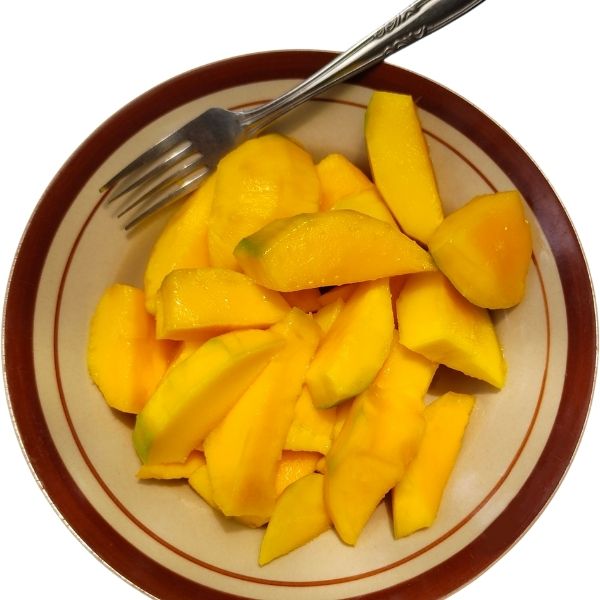
Mastering the Mango Grid Method for Cubes:
If you’re looking to add mango to salsas or as a topping, this method gives you even cubes:
- Slice the Cheeks: As with the previous method, start by slicing off the cheeks of the mango.
- Score a Grid: Score a grid pattern on each cheek. The size of the grid will determine the size of your cubes.
- Push and Invert: Gently push the skin side, turning the cheek inside out. The cubes will pop up.
- Cut Away the Cubes: Carefully slice off the cubes from the skin.
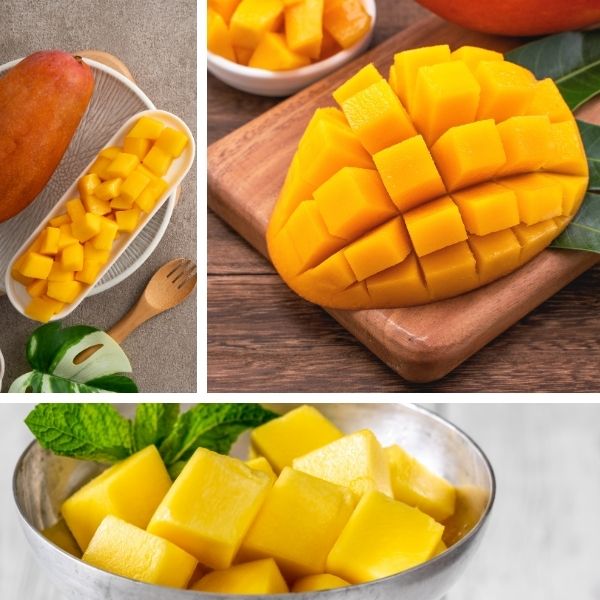
How to Use a Mango Splitter:
A mango splitter simplifies the process of removing the pit:
- Position the Mango: Stand the mango upright with the stem facing downwards.
- Align the Splitter: Place the splitter on top of the mango, centering it around the pit.
- Press Down Firmly: Apply even pressure and press down. The splitter will cut through the mango, separating the flesh from the pit.
- Remove the Cheeks: You can now easily remove the cheeks and proceed to slice or cube them as desired.
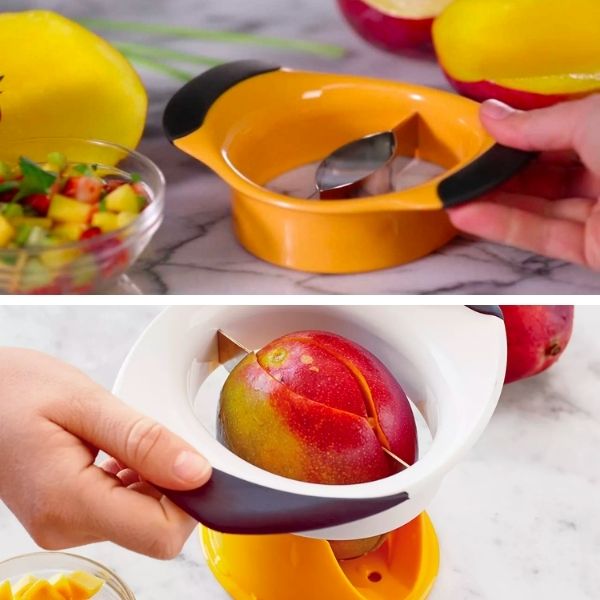
With these techniques, you’ll be able to handle any mango that comes your way. In our next section, we’ll explore advanced techniques for those looking to get a bit more creative with their mango preparations.
Advanced Mango Preparation Techniques
Artistic Mango Ribbons:
For a visually stunning addition to salads or as a garnish, mango ribbons are a perfect choice. Here’s how to create them:
- Peel the Mango: Start by peeling the mango skin using a sharp vegetable peeler or a small knife.
- Create Ribbons: Hold the peeled mango in one hand. With the other hand, use the peeler or knife to create long, thin slices of mango, creating ribbon-like strips.
Mango Prep for Specific Dishes:
Different dishes require different cuts of mango. Here are some specialized preparation tips:
- For Thai Mango Salad: Opt for julienne slices. Cut the mango into thin, matchstick-like strips to blend well with other ingredients.
- For Mango Salsa: Dice the mango into small, even cubes for a uniform texture that mixes well with other salsa components.
- For Desserts: Depending on the dessert, you might need finely chopped mango or pureed mango. Adjust your cutting technique based on the recipe requirements.
Peeling Techniques for Softer Mangoes:
Softer mangoes can be a bit more challenging to handle. Here are some techniques:
- Using a Glass: Cut the mango into cheeks. Hold a cheek with the flesh facing outwards and use the rim of a glass to separate the flesh from the skin by sliding the glass in between.
- Scooping: For very ripe mangoes, simply scoop out the flesh with a spoon. This method works great for mangoes that are too soft for slicing or dicing.
These advanced techniques allow you to handle mangoes of various ripeness levels and use them in diverse culinary applications. Up next, we’ll look at the best practices for storing your cut mangoes to maintain their freshness.
Storing Cut Mango
Refrigeration Best Practices:
Proper mango storage is key to preserving the freshness of cut mangoes. Here’s how to store them in the refrigerator:
- Use Airtight Containers: Transfer the cut mango pieces into an airtight container. This helps to retain their freshness and prevent them from absorbing odors from other foods in the fridge.
- Refrigeration Time: Properly stored, cut mangoes can last in the refrigerator for up to four to five days.
Freezing for Longevity:
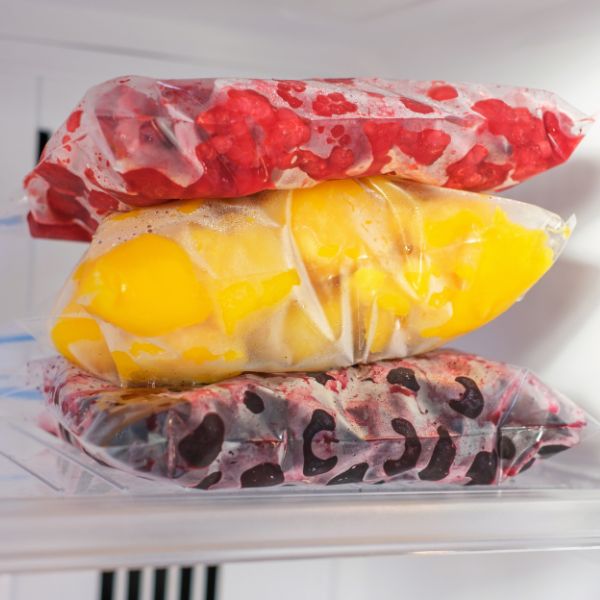
Freezing mangoes is an excellent way to extend their shelf life and enjoy them out of season. Follow these steps for freezing:
- Prep for Freezing: Lay the cut mango pieces on a baking sheet lined with parchment paper. Make sure the pieces are not touching each other; this prevents them from freezing into a single clump.
- Flash Freeze: Place the tray in the freezer for a few hours until the mango pieces are frozen solid.
- Final Storage: Once frozen, transfer the mango pieces to a freezer-safe airtight container or ziplock bag. They can be stored in the freezer for up to six months.
Frozen mangoes are perfect for smoothies, as a cold snack, or even as a natural sweetener for desserts.
With your mangoes safely stored, you can enjoy their tropical flavor long after you’ve cut them. Next, we’ll explore creative ways to use your prepared mangoes in various dishes.
Creative Ways to Enjoy Prepared Mango
Mango in Recipes:
Now that you’ve mastered the art of preparing mangoes, it’s time to explore their culinary versatility. Here are some creative ways to incorporate mangoes into your recipes:
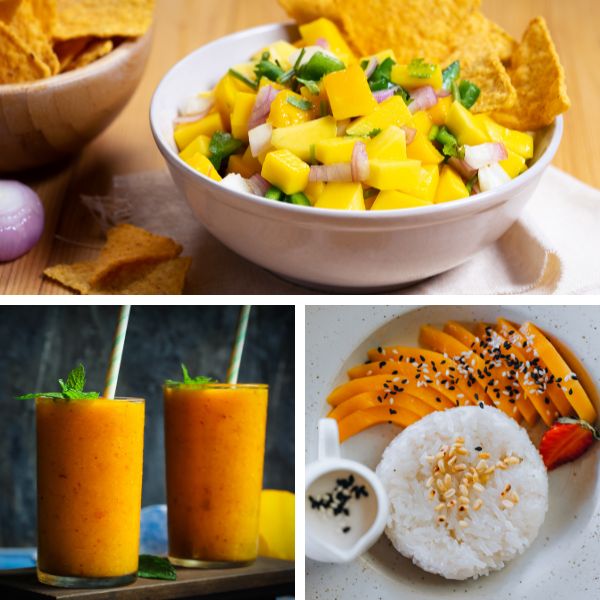
- Mango Salsa: Combine diced mango with red onion, jalapeño, cilantro, lime juice, and a pinch of salt for a refreshing salsa. Perfect with chips or as a topping for grilled fish or chicken.
- Mango Smoothies: Blend mango cubes with yogurt, a splash of milk or juice, and a touch of honey for a deliciously creamy smoothie. You can also add other fruits like banana or berries for added flavor.
- Mango Salad: Toss mango slices with mixed greens, avocado, nuts, and a light vinaigrette for a tropical twist on a classic salad.
Pairing Mangoes with Other Foods:
Mangoes pair beautifully with a variety of foods. Here are some pairing ideas:

- With Spicy Foods: The sweetness of mango balances the heat in spicy dishes like curries or tacos.
- With Creamy Cheeses: Mango slices go well with creamy cheeses like brie or goat cheese, making for an excellent addition to cheese platters.
- With Seafood: Mango’s sweet and tangy flavor complements seafood, particularly shrimp and fish.
Mango as a Standalone Treat:
Sometimes, the best way to enjoy a mango is on its own. Here are some simple yet delightful ways to savor mangoes:
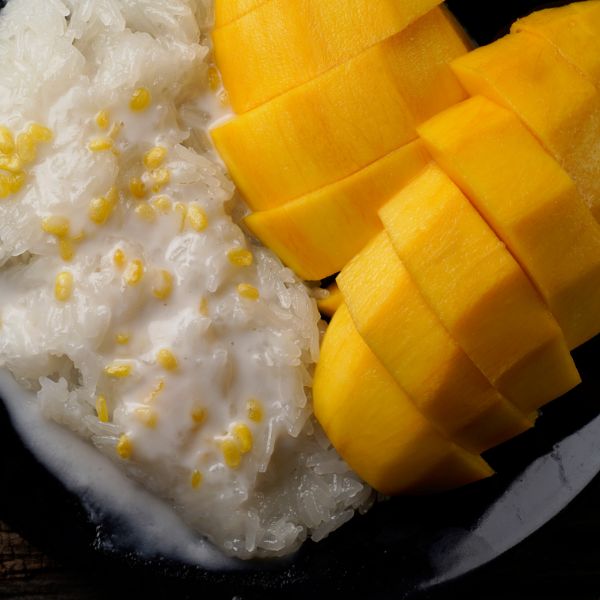
- Chilled Mango: Refrigerate mango slices for a cool, refreshing treat.
- Mango with a Twist: Sprinkle a little chili powder and lime juice on mango cubes for a burst of flavor.
- Mango Dessert: Top a bowl of fresh mango cubes with a scoop of vanilla ice cream or a dollop of whipped cream for a quick and easy dessert.
Mangoes, with their vibrant flavor and color, can brighten up any meal. Let your creativity flow and enjoy the tropical flair they bring to your dishes!
Health Benefits of Mango
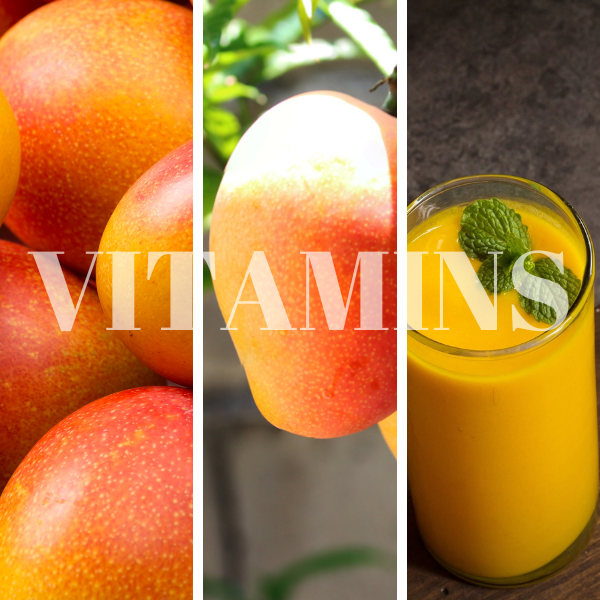
Nutritional Profile:
Mangoes aren’t just delicious; they’re a powerhouse of nutrition. Rich in vitamins C and A, mangoes are excellent for boosting immunity and skin health. They are also a good source of dietary fiber, which aids in digestion.
The Wellness Advantage:
Regular consumption of mangoes can have several health benefits:
- Digestive Health: The enzymes in mangoes help in breaking down protein and improving digestion.
- Immune Support: The high vitamin C content in mangoes supports the immune system.
- Eye Health: Mangoes contain beta-carotene, which is vital for eye health and vision.
By incorporating mangoes into your diet, you’re not only enjoying their taste but also benefiting from their numerous health properties.
Your Questions Answered: Mango Preparation FAQ
We understand that preparing and enjoying mangoes can come with a lot of questions, especially if you’re trying new methods or experimenting with different recipes. To help you further, we’ve compiled a list of frequently asked questions. This section aims to provide quick, clear answers to some of the most common questions about mango preparation and consumption. Whether you’re curious about the right way to cut a mango, how to tell if it’s ripe, or the best methods to enjoy it, we’ve got you covered.
Q: What is the best way to prepare a mango?
A: The best way to prepare a mango depends on your intended use. For salads or salsas, the grid method for cubes works well. For smoothies or purees, scooping the flesh from a ripe mango is ideal. The traditional slice and scoop method is great for general purposes.
Q: Do you have to peel a mango before eating it?
A: Yes, it’s recommended to peel a mango before eating, as the skin can be tough and bitter. The flesh inside is the edible part.
Q: How do you cut and eat fresh mangoes?
A: You can cut mangoes by slicing off the cheeks and scoring them for cubes or slices. Eat fresh mangoes as is, in salads, salsas, smoothies, or desserts.
Q: How is a mango ready to eat?
A: A mango is ready to eat when it’s slightly soft to the touch and emits a fruity aroma at the stem end. The skin may also change color depending on the variety.
Q: Can you eat a mango raw?
A: Absolutely! Mangoes are delicious and nutritious when eaten raw, and they can be a sweet and refreshing snack.
Q: What are 3 ways to eat a mango?
A: Three popular ways to eat a mango are: 1) sliced and eaten fresh, 2) diced in salsas or salads, and 3) blended in smoothies.
Q: Why do we soak mangoes in water before eating?
A: Soaking mangoes in water is believed to remove excess heat from the fruit, making it cooler and more refreshing to eat. This practice is common in some cultures, especially in areas where mangoes grow abundantly.
Q: Is it OK to eat a whole mango?
A: Yes, it’s okay to eat a whole mango, as long as you avoid the pit and skin. However, keep in mind that mangoes are high in sugar, so moderation is key.
Q: Why should we wash mango before eating?
A: Washing a mango before eating is important to remove any surface dirt, pesticides, or bacteria. It ensures the mango is clean and safe to consume.
Q: What color is a ripe mango?
A: The color of a ripe mango can vary by variety. Some turn bright yellow, orange, or red, while others remain partially green. Color is one indicator, but feel and aroma are also important in determining ripeness.
Q: How do you know when a mango goes bad?
A: A mango has gone bad if it’s overly soft or mushy, has dark spots on the skin, emits a sour or alcoholic smell, or shows signs of mold. If in doubt, it’s best to discard it.
